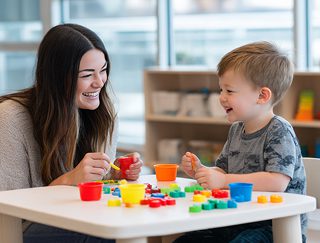

Advances in Autism Screening Technology: A Family Guide to Early Detection and Support
Advances in Autism Screening Technology: A Family Guide to Early Detection and Support
Table of Contents
Seeking a Personalized Assessment?
Connect With Us Today »Parents often describe a feeling that something is “different,” even before they have the language for it. Maybe a child communicates in unique ways, new situations feel harder than expected, or a skill they once used regularly – like a familiar word or a small step in their usual dressing or mealtime routine – seems to fade. These early observations can bring a mix of curiosity and concern, and it’s completely understandable to want clarity and reassurance. Early information can help families feel grounded and confident in their next steps.
With advances in autism screening technology, families now have tools that identify early signs sooner, while making the experience more welcoming and child-centered.
This guide explores early signs, modern screening approaches, and how clinics like Talcott use innovation to support each child’s strengths.
Understanding Autism and Its Early Signs
Many families notice small behaviors in their child long before they know whether those moments are meaningful. Early signs of autism can be subtle, often overlapping with typical toddler development or dismissed as personality quirks. That’s why steady, supportive observation over time is so helpful.
When early signs are recognized, families can take steps that support communication, connection, and everyday comfort.
What is Autism Spectrum Disorder?
Autism, also called Autism Spectrum Disorder (ASD), affects how children communicate, learn, and interact with the world.
Children on the autism spectrum show their strengths and challenges in many ways, such as:
- Communication differences: Some children use fewer words but express themselves through gestures, facial expressions, or imaginative play. Others may use familiar lines or “scripts” from favorite shows, songs, or people as a way to express themselves or join in social moments. For example, a toddler might point to show what they want, act out a story with a toy, or repeat a favorite phrase at times when they’re excited or unsure how to respond.
- Focused interests: Others might become deeply interested in a particular topic, like trains, animals, or shapes, and enjoy exploring it in detail for long periods.
- Preference for routines: Some children find comfort in predictable routines. A child may line up toys in a certain order, follow the same steps during bedtime, or rely on familiar patterns to move through the day. This strong need for predictability can also play into areas where transitions become difficult, especially during outings in the community or when faced with unfamiliar environments or unexpected changes in expectations.
- Unique ways of exploring: A child might interact with toys differently from peers, like spinning wheels repeatedly, stacking blocks in patterns, or watching water move rather than using it in pretend play.
- Social differences: One child may enjoy social interaction but have trouble interpreting tone of voice, facial expressions, or body language.
- Independent play preference: Another child may prefer quiet, solitary activities, like reading books, drawing, or playing alone with toys, even in a group setting.
- Sensory responses: Some children may notice textures, sounds, or lights more intensely, for instance, covering ears at a vacuum sound or enjoying the feel of sand.
These patterns vary widely. There is no single “profile” of autism, and each child’s traits are shaped by their personality, preferences, and developing skills. Understanding this range helps families recognize behaviors while appreciating the individuality behind them.
Why Detecting Autism Early Matters
Identifying autism early allows children to receive support when their brains are developing most rapidly.
Early intervention can:
- strengthen communication,
- help with emotional regulation, and
- make everyday routines feel more manageable for families.
Early awareness doesn’t change who a child is. It simply helps everyone understand them more clearly, so care can grow with them, step by step.
Advances in Autism Screening Technology
New advances in autism screening give clinicians a clearer look at early developmental differences and the likelihood that a child may show traits associated with autism. These screenings do not provide a diagnosis. Instead, they help identify early risk factors and determine whether a child would benefit from a full diagnostic evaluation.
When combined with professional guidance, these innovations help families understand whether further evaluation is recommended. Parent observations remain one of the most important parts of early screening, and many tools rely on family reports to create a fuller, more accurate picture of a child’s development.
Interactive Tools for Early Screening
Interactive screenings let children participate naturally through play. These tools are designed to feel engaging and low-pressure, giving kids a chance to show their skills in a way that feels like fun, not testing.
- Digital games and apps: Platforms like Cognoa use child-friendly games that explore shapes, colors, matching, or sorting. Children’s choices, speed, and problem-solving reveal early skills in attention, memory, and communication.
- Storytelling and puppet play on tablets: Some apps guide children through short stories or imaginative play, allowing clinicians to see how kids express ideas, use gestures, and respond to social cues.
- Motion- or touch-sensitive tasks: Tools equipped with motion sensors or interactive touchscreens track how children reach, point, or manipulate virtual objects. This helps assess coordination, focus, and engagement while keeping play at the center.
- Integrated observation features: Certain platforms combine touchscreen interactions, gesture tracking, and response timing to provide a rich picture of a child’s developmental skills.
The Role of Genetics in Autism
Genetics can influence how autism appears, offering insights into each child’s unique profile.
While genetics doesn’t provide all the answers, it supports more informed planning and early intervention.
- Genetic testing panels: Modern sequencing can identify variations linked to developmental differences, such as communication, sensory processing, or motor coordination.
- AI-assisted interpretation: Some platforms analyze genetic data alongside behavioral observations to create a fuller developmental picture.
- Tailored planning: Understanding potential genetic influences helps therapists and families choose strategies aligned with a child’s strengths and likely areas of need.
Genetic information, combined with everyday observations, helps families anticipate needs and personalize supports from the earliest stages.
Using AI to Improve Screening
Artificial intelligence enhances screening by identifying subtle patterns clinicians may not see during brief observations. AI supports clinical judgment rather than replacing it, offering another layer of information that can guide next steps.
Although promising, many AI-based platforms are still in active research phases, with accuracy and reliability monitored as the technology evolves. These tools are not yet widely available in every setting, and their use can vary depending on region, provider, and clinical resources.
While some platforms claim to follow principles of “responsible AI,” there are currently no universal standards or regulations to ensure consistency, so these tools should be viewed as supportive rather than definitive.
To understand how AI contributes to early screening, it helps to look at the kinds of information these tools can analyze:
- Video analysis of expressions and gestures: Platforms like Autism & Beyond review facial expressions, eye contact, and hand movements to identify early differences in social communication.
- Voice and sound tracking: AI can analyze tone, pitch, and vocal patterns to detect early communication differences.
- Behavioral pattern analysis over time: Machine learning compares a child’s behaviors against typical developmental milestones, helping clinicians identify areas that may benefit from early support.
- Comprehensive developmental insight: Advanced platforms can integrate multiple data streams (like video, audio, and milestone tracking) to give clinicians a more complete view of a child’s strengths and challenges.
AI helps highlight subtle developmental patterns, but it should be used alongside professional expertise, parent observations, and comprehensive evaluations.
Breakthroughs in Autism Diagnosis
Recent technology is making autism diagnosis more accurate, accessible, and timely. Tools like telehealth, video-based assessments, and secure virtual consultations allow clinicians to observe communication, play, and social behaviors even when families can’t visit a specialty clinic.
Telehealth: Bringing Help Home
Telehealth has become an important tool in autism diagnostics and early support. Families living far from specialty clinics or with limited access to experts can receive guidance, assessments, and follow-up consultations from home.
- Virtual developmental assessments: Clinicians can observe children’s play, communication, and social interactions via secure video platforms, identifying areas for early support.
- Parent coaching and guidance: Families receive real-time advice on supporting communication, daily routines, or play at home, empowering caregivers to participate actively in their child’s development.
- Connecting with specialists: Families in rural or underserved areas can access pediatric therapists, BCBAs, or multidisciplinary teams without extensive travel, ensuring timely and practical recommendations.
Telehealth doesn’t replace hands-on therapy, but it helps families gather reliable information sooner, track progress, and make informed decisions about clinic-based services.
Bringing Innovation to Everyday Care
Every day, new tools and approaches are helping children with autism engage more fully in therapy. At Talcott, these innovations support a play-based, family-centered model that builds on each child’s strengths, making therapy both meaningful and effective.
How Technology Transforms Pediatric Care
Technology can create opportunities for children to practice skills in a more enjoyable setting. For example:
- Interactive apps and video platforms: Children explore communication, social interaction, and problem-solving through playful, guided activities. Therapists use these tools to observe engagement and tailor strategies to each child’s needs.
- Virtual reality (VR) simulations: VR provides safe, controlled environments for practicing social situations or daily routines, helping children build confidence in new skills.
- Progress-tracking platforms: Digital tools allow families and therapists to monitor development over time, making it easier to adjust supports as children grow and change.
These innovations enhance the therapeutic experience, giving families earlier insight, supporting practice between sessions, and helping children engage more actively in their own learning.
Parents and Caregivers: Key Partners in Screening
Technology now offers new ways for families to participate, making therapy even more personalized and effective.
Families can use innovative approaches by:
- Keeping digital records of milestones, play, and communication patterns
- Using apps and tools to reinforce strategies at home and track progress
- Participating in virtual coaching sessions to receive guidance on supporting routines, play, and communication skills
By sharing insights about daily routines, preferences, and strengths, families become active partners in shaping therapy that is meaningful, responsive, and enjoyable for their child.
Family Resources and Support
Once screening provides insights into a child’s strengths and needs, families can access resources to translate that information into everyday strategies.
Building Your Support Network
A strong network of professionals, peers, and loved ones ensures guidance is coordinated, practical, and emotionally supportive.
Families can strengthen their network by:
- Connecting with other families: Local or online parent groups provide a safe space to share experiences, ask questions, and exchange strategies that have worked in real life.
- Engaging with multidisciplinary professionals: BCBAs, speech therapists, occupational therapists, and physical therapists collaborate to support your child’s growth. Regular communication ensures guidance is coordinated and responsive.
- Collaborating actively with your care team: Participating in planning, progress discussions, and therapy updates reinforces a sense of shared purpose. Families feel confident knowing they are not navigating this journey alone.
Personalizing Interventions for Your Child
Every child learns and engages differently. Tailoring strategies to your child’s interests, strengths, and preferences makes learning feel natural and motivating.
For example, incorporating favorite toys or activities into communication, play, or daily living skills supports engagement and helps children practice new skills in a natural, motivating context.
Families play an essential role in personalizing supports by:
- Implementing, monitoring, and enhancing routines at home,
- Sharing insights about what excites or calms your child, and
- Participating in guided coaching sessions.
When families collaborate with the care team, interventions stay relevant, effective, and joyful every day.
How Talcott Supports Your Autism Journey
Screening provides valuable insight into your child’s strengths and needs, guiding how we tailor therapy to support meaningful everyday growth. At Talcott, we offer a full spectrum of services to help families along their autism journey.
Comprehensive, Collaborative Services
Our programs include:
- ABA-Based Autism Day Programs for structured, skill-building therapy
- Support in communication, play, daily living skills, and motor development
- Multidisciplinary therapies, including:
- Speech therapy: Focuses on helping children improve communication skills, including speech, language, social communication, and understanding or expressing ideas.
- Occupational therapy: Supports children in developing everyday skills such as fine motor coordination, self-care, sensory processing, and independent functioning.
- Physical therapy: Targets gross motor skills, balance, strength, and coordination, helping children move safely and confidently.
- Feeding therapy: Helps children develop safe, comfortable eating habits, including chewing, swallowing, texture tolerance, and mealtime routines.
At Talcott, these services are coordinated through a collaborative care model. BCBAs, therapists, and support staff work together to ensure interventions are aligned, responsive to each child’s strengths, and integrated across all areas of development.
Families benefit from a seamless, team-based approach that keeps therapy meaningful, consistent, and empowering.
Joyful, Child-Centered Learning
We believe therapy should feel fun, not stressful. Children practice skills in ways that feel natural through:
- Individualized instruction tailored to each child’s strengths
- Small-group and one-on-one support
- Activities that make learning playful and motivating
Collaborative Care for Every Family
Families are at the heart of meaningful progress. At Talcott, we focus on giving parents and caregivers the tools to support learning beyond the clinic.
Through hands-on coaching, ongoing communication, and real-time modeling, we help families:
- Learn strategies that fit naturally into daily routines
- Support communication, play, and independence at home and in the community
- Build confidence in reinforcing new skills throughout the day
This partnership ensures therapy doesn’t end when a session does. Instead, families feel supported, equipped, and empowered to help their child grow in every environment.
Our Promise of Innovation and Care
Talcott integrates the latest research and evidence-based practices into therapy.
While we don’t offer telehealth or every type of screening technology, we carefully select trusted, research-backed tools to ensure interventions are safe, effective, and grounded in best practices.
We leverage technology to enhance therapy, using interactive, play-based platforms and digital tools that let children explore, engage, and respond to new challenges. These tools help therapists track progress, tailor strategies, and support learning both in the clinic and at home, so families see measurable improvements in communication, social interaction, and daily participation.
Take the Next Step
Wondering how Talcott’s collaborative, play-based approach can support your child?
Fill out the form to schedule a tour or consultation, see our programs in action, meet our therapists and BCBAs, and experience how we partner with families to help every child thrive.

















